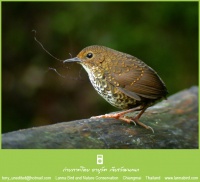m (corrected scientific name) |
|||
| Line 1: | Line 1: | ||
| − | <div style="{{psubheader}}">Featured Article: '''[[ | + | <div style="{{psubheader}}">Featured Article: '''[[Pygmy Wren Babbler]]'''</div> |
''Anthus rubescens'' | ''Anthus rubescens'' | ||
| − | [[Image: | + | [[Image:Pygmy_Wren_Babbler.jpg|thumb|200px|left|Photo by Ayuwat<br />Photo taken: Doi Inthanon, Chiangmai, [[Thailand]]]] |
| − | + | More often heard than seen. Forages on the ground, sometimes up to 2m in trees, feeding on ants, other insects and spiders.<br /> | |
| + | Breeding season differs through range, March to September in northern parts, July to May in Java, November to December in Sumatra. The nest is a ball of moss or a built-in structure made of long strands of green moss, the inner part formed to a cup. It's placed in moss, orchids, ferns or creepers hanging down from large trees, close to the ground. Lays 2 - 6 eggs.<br /> | ||
| + | Resident species with some local altitudinal movements. '''[''[[Pygmy Wren Babbler|Read More...]]'']''' | ||
Revision as of 16:12, 9 June 2009
Anthus rubescens
More often heard than seen. Forages on the ground, sometimes up to 2m in trees, feeding on ants, other insects and spiders.
Breeding season differs through range, March to September in northern parts, July to May in Java, November to December in Sumatra. The nest is a ball of moss or a built-in structure made of long strands of green moss, the inner part formed to a cup. It's placed in moss, orchids, ferns or creepers hanging down from large trees, close to the ground. Lays 2 - 6 eggs.
Resident species with some local altitudinal movements. [Read More...]




